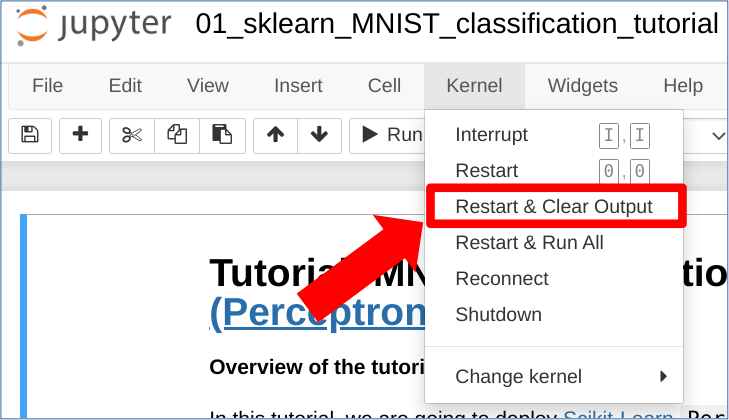MNIST classification with Scikit-Learn Classifier (Perceptron)¶
Overview of the tutorial:
In this tutorial, we are going to train Scikit-Learn Perceptron as a federated model model over a Node.
At the end of this tutorial, you will learn:
- how to define a Sklearn classifier in Fed-BioMed (especially
Perceptronmodel) - how to train it
- how to evaluate the resulting model
HINT : to reload the notebook, please click on the following button:
Kernel -> Restart and clear Output

1. Clean your environments¶
Before executing notebook and starting nodes, it is safer to remove all configuration scripts automatically generated by Fed-BioMed. To do so, enter the following in a terminal:
source ${FEDBIOMED_DIR}/scripts/fedbiomed_environment cleanNote: ${FEDBIOMED_DIR} is a path relative to based directory of the cloned Fed-BioMed repository. You can set it by running command export FEDBIOMED_DIR=/path/to/fedbiomed. This is not required for Fed-BioMed to work but enables you to run the tutorials more easily.
2. Setting the node up¶
It is necessary to previously configure a Network and a Nodebefore runnig this notebook:
${FEDBIOMED_DIR}/scripts/fedbiomed_run network${FEDBIOMED_DIR}/scripts/fedbiomed_run node add- Select option 2 (default) to add MNIST to the node
- Confirm default tags by hitting "y" and ENTER
- Pick the folder where MNIST is downloaded (this is due torch issue https://github.com/pytorch/vision/issues/3549)
- Data must have been added (if you get a warning saying that data must be unique is because it has been already added)
Check that your data has been added by executing
${FEDBIOMED_DIR}/scripts/fedbiomed_run node list- Run the node using
${FEDBIOMED_DIR}/scripts/fedbiomed_run node start. Wait until you getConnected with result code 0. it means your node is working and ready to participate to a Federated training.
More details are given in tutorial : Installation/setting up environment
3. Create Sklearn Federated Perceptron model¶
The class SGDSkLearnModel constitutes the Fed-BioMed wrapper for executing Federated Learning using Scikit-Learn models based on Stochastic Gradient Descent (SGD). It provides the Perceptron model. As we have done with Pytorch model in previous chapter, we create a new class SGDPerceptronTrainingPlan that inherits from it.
Create a temporary folder to store your model (that will be sent to the nodes for training).
import tempfile
import os
from fedbiomed.researcher.environ import environ
tmp_dir_model = tempfile.TemporaryDirectory(dir=environ['TMP_DIR']+os.sep)
model_file = os.path.join(tmp_dir_model.name, 'class_export_mnist.py')
WARNING : write only the code to export in the following cell
%%writefile "$model_file"
from fedbiomed.common.fedbiosklearn import SGDSkLearnModel
import numpy as np
class SkLearnClassifierTrainingPlan(SGDSkLearnModel):
def __init__(self, model_args):
super(SkLearnClassifierTrainingPlan,self).__init__(model_args)
self.add_dependency(['import torch',
"from sklearn.linear_model import Perceptron",
"from torchvision import datasets, transforms",
"from torch.utils.data import DataLoader"])
def training_data(self):
# Custom torch Dataloader for MNIST data
transform = transforms.Compose([transforms.ToTensor(),
transforms.Normalize((0.1307,), (0.3081,))])
dataset = datasets.MNIST(self.dataset_path, train=True, download=False, transform=transform)
train_kwargs = {'batch_size': 500, 'shuffle': True} # number of data passed to classifier
X_train = dataset.data.numpy()
X_train = X_train.reshape(-1, 28*28)
Y_train = dataset.targets.numpy()
return X_train, Y_train
This group of arguments corresponds respectively to:
model_args: a dictionary with the arguments related to the model (e.g. number of layers, features, etc.). This will be passed to the model class on the node side.training_args: a dictionary containing the arguments for the training routine (e.g. batch size, learning rate, epochs, etc.). This will be passed to the routine on the node side.
model_args = { 'max_iter':1000,
'tol': 1e-4 ,
'model': 'Perceptron' ,
'n_features': 28*28,
'n_classes' : 10,
'eta0':1e-6,
'random_state':1234,
'alpha':0.1 }
training_args = {
'epochs': 1,
}
4. Train your model on MNIST dataset¶
MNIST dataset is composed of handwritten digits images, from 0 to 9. The purpose of our classifier is to associate an image to the corresponding represented digit
from fedbiomed.researcher.experiment import Experiment
from fedbiomed.researcher.aggregators.fedavg import FedAverage
tags = ['#MNIST', '#dataset']
rounds = 50
# select nodes participing to this experiment
exp = Experiment(tags=tags,
model_path=model_file,
model_args=model_args,
model_class='SkLearnClassifierTrainingPlan',
training_args=training_args,
round_limit=rounds,
aggregator=FedAverage(),
node_selection_strategy=None)
One should notice that model_path argument in Experiment is only needed when running Fed-Biomed on jupyter notebooks (not for plain Python scripts).
exp.run()
5. Testing on MNIST test dataset¶
Lets assess performance of our clssifier with MNIST testing dataset
from torchvision import datasets, transforms
from sklearn.preprocessing import LabelBinarizer
import numpy as np
# collecting MNIST testing dataset: for that we are downloding the whole dataset on en temporary file
transform = transforms.Compose([transforms.ToTensor(),
transforms.Normalize((0.1307,), (0.3081,))])
testing_MNIST_dataset = datasets.MNIST(root = os.path.join(environ['TMP_DIR'], 'local_mnist.tmp'),
download = True,
train = False,
transform = transform)
testing_MNIST_data = testing_MNIST_dataset.data.numpy().reshape(-1, 28*28)
testing_MNIST_targets = testing_MNIST_dataset.targets.numpy()
6. Getting Loss function¶
Here we use the aggregated_params() getter to access all model weights at the end of each round to plot the evolution of Percpetron loss funciton, as well as its accuracy.
# retrieve Sklearn model and losses at the end of each round
from sklearn.linear_model import Perceptron
from sklearn.metrics import accuracy_score, confusion_matrix, hinge_loss
fed_perceptron_model = Perceptron()
perceptron_args = {key: model_args[key] for key in model_args.keys() if key in fed_perceptron_model.get_params().keys()}
losses = []
accuracies = []
for r in range(rounds):
fed_perceptron_model = fed_perceptron_model.set_params(**perceptron_args)
fed_perceptron_model.classes_ = np.unique(testing_MNIST_dataset.targets.numpy())
fed_perceptron_model.coef_ = exp.aggregated_params()[r]['params']['coef_'].copy()
fed_perceptron_model.intercept_ = exp.aggregated_params()[r]['params']['intercept_'].copy()
prediction = fed_perceptron_model.decision_function(testing_MNIST_data)
losses.append(hinge_loss(testing_MNIST_targets, prediction))
accuracies.append(fed_perceptron_model.score(testing_MNIST_data,
testing_MNIST_targets))
7. Comparison with a local Perceptron model¶
In this section, we implement a local Perceptron model, so we can compare remote and local models accuracies.
# downloading MNIST dataset
training_MNIST_dataset = datasets.MNIST(root = os.path.join(environ['TMP_DIR'], 'local_mnist.tmp'),
download = True,
train = True,
transform = transform)
training_MNIST_data = training_MNIST_dataset.data.numpy().reshape(-1, 28*28)
training_MNIST_targets = training_MNIST_dataset.targets.numpy()
Local Model training loop : the Percpetron model is trained locally, then compared with the remote Perceptron model
local_perceptron_losses = []
local_perceptron_accuracies = []
local_perceptron_model = Perceptron()
perceptron_args = {key: model_args[key] for key in model_args.keys() if key in fed_perceptron_model.get_params().keys()}
local_perceptron_model.set_params(**perceptron_args)
classes = np.unique(training_MNIST_targets)
for r in range(rounds):
for e in range(training_args["epochs"]):
local_perceptron_model.partial_fit(training_MNIST_data,
training_MNIST_targets,
classes=classes)
predictions = local_perceptron_model.decision_function(testing_MNIST_data)
local_perceptron_losses.append(hinge_loss(testing_MNIST_targets, predictions))
local_perceptron_accuracies.append(local_perceptron_model.score(testing_MNIST_data,
testing_MNIST_targets))
!pip install matplotlib
import matplotlib.pyplot as plt
plt.figure(figsize=(10,5))
plt.subplot(1,2,1)
plt.plot(losses, label="federated Perceptron losses")
plt.plot(local_perceptron_losses, "--", color='r', label="local Perceptron losses")
plt.ylabel('Perceptron Cost Function (Hinge)')
plt.xlabel('Number of Rounds')
plt.title('Perceptron loss evolution on test dataset')
plt.legend()
plt.subplot(1,2,2)
plt.plot(accuracies, label="federated Perceptron accuracies")
plt.plot(local_perceptron_accuracies, "--", color='r',
label="local Perceptron accuracies")
plt.ylabel('Accuracy')
plt.xlabel('Number of Rounds')
plt.title('Perceptron accuracy over rounds (on test dataset)')
plt.legend()
<matplotlib.legend.Legend at 0x7faf8bf7ef70>
In this example, plots appear to be the same: this means that Federated and local Perceptron models are performing equivalently!
8. Getting accuracy and confusion matrix¶
# federated model predictions
fed_prediction = fed_perceptron_model.predict(testing_MNIST_data)
acc = accuracy_score(testing_MNIST_targets, fed_prediction)
print('Federated Perceptron Model accuracy :', acc)
# local model predictions
local_prediction = local_perceptron_model.predict(testing_MNIST_data)
acc = accuracy_score(testing_MNIST_targets, local_prediction)
print('Local Perceptron Model accuracy :', acc)
Federated Perceptron Model accuracy : 0.8773 Local Perceptron Model accuracy : 0.8773
def plot_confusion_matrix(fig, ax, conf_matrix, title, xlabel, ylabel, n_image=0):
im = ax[n_image].imshow(conf_matrix)
ax[n_image].set_xticks(np.arange(10))
ax[n_image].set_yticks(np.arange(10))
for i in range(conf_matrix.shape[0]):
for j in range(conf_matrix.shape[1]):
text = ax[n_image].text(j, i, conf_matrix[i, j],
ha="center", va="center", color="w")
ax[n_image].set_xlabel(xlabel)
ax[n_image].set_ylabel(ylabel)
ax[n_image].set_title(title)
fed_conf_matrix = confusion_matrix(testing_MNIST_targets, fed_prediction)
local_conf_matrix = confusion_matrix(testing_MNIST_targets, local_prediction)
fig, axs = plt.subplots(nrows=1, ncols=2,figsize=(10,5))
plot_confusion_matrix(fig, axs, fed_conf_matrix,
"Federated Perceptron Confusion Matrix",
"Actual values", "Predicted values", n_image=0)
plot_confusion_matrix(fig, axs, local_conf_matrix,
"Local Perceptron Confusion Matrix",
"Actual values", "Predicted values", n_image=1)
Congrats !¶
You have figured out how to train your first Federated Sklearn classifier model !
If you want to practise more, you can try to deploy such classifier on two or more nodes. As you can see, Perceptron is a limited model: its generalization is SGDCLassifier. You can thus try to apply SGDCLassifier, providing more feature such as different cost functions, regularizations and learning rate decays.
Don't miss out other tutorials about Federated Sklearn models, and consult user guide for further information.


